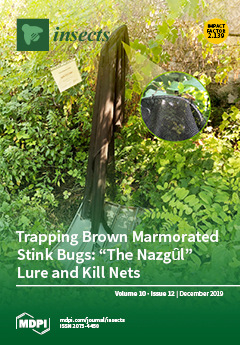Biological control is an effective method for whitefly management compared to the potential problems caused by chemical control, including environmental pollution and the development of resistance. Combined use of insect parasitoids and entomopathogenic fungi has shown high efficiency in
Bemisia tabaci control. Here, we assessed the impacts of an entomopathogenic fungus,
Cordyceps javanica, on the parasitism rate of a dominant whitefly parasitoid,
Eretmocerus hayati, and for the first time also compared their separate and combined potential in the suppression of
B. tabaci under semi-field conditions. Six conidial concentrations of
C. javanica (1 × 10
3, 1 × 10
4, 1 × 10
5, 1 × 10
6, 1 × 10
7 and 1 × 10
8 conidia/mL) were used to assess its pathogenicity to the pupae and adults of
E. hayati. Results showed that the mortality of
E. hayati increased with higher concentrations of
C. javanica, but these higher concentrations of fungus had low pathogenicity to both the
E. hayati pupae (2.00–28.00% mortality) and adults (2.67–34.00% mortality) relative to their pathogenicity to
B. tabaci nymphs (33.33–92.68%). Bioassay results indicated that
C. javanica was harmless (LC
50 = 3.91 × 10
10) and slightly harmful (LC
50 = 5.56 × 10
9) to the pupae and adults of
E. hayati respectively on the basis of IOBC criteria, and that
E. hayati could parasitize all nymphal instars of
B. tabaci that were pretreated with
C. javanica, with its rate of parasitism being highest on second-instar nymphs (62.03%). Interestingly, the parasitoids from second and third-instar
B. tabaci nymphs infected with
C. javanica had progeny with increased longevity and developmental periods. Moreover, experimental data from 15 day semi-field studies indicate that combined application of
C. javanica and
E. hayati suppresses
B. tabaci with higher efficiency than individual applications of both agents. Therefore, combined applications of
C. javanica (1 × 10
8 conidia/mL) and
E. hayati is a more effective and compatible biological control strategy for management of
B. tabaci than using either of them individually.
Full article






